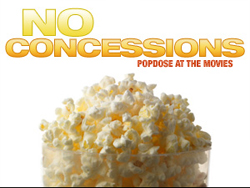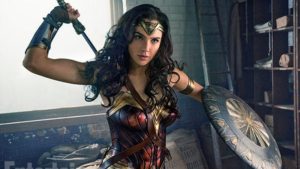 Crummy. Slummy. Bummy. The Mummy.
Crummy. Slummy. Bummy. The Mummy.
Franchise exhaustion continues with a desperate attempt to turn Universal’s beloved Golden Age of Hollywood monsters into supernaturally charged action figures for the less discerning members of the global audience, the same one that keeps turning out for more Resident Evil and Underworld sequels. If it were a January release throwaway cast with a TV star or two, it might be tolerable. But this is playing in the big leagues, with an upscale budget and production, and Tom Cruise in the lead. The studio’s intermittent revivals of its legacy, including Van Helsing (2004) and Dracula Untold (2014), have been woeful, and this is the most baffling of all, a first piece of a planned “Dark Universe” from a superhero-challenged company that is looking gloomy indeed.
Alien: Covenant was awful, but going in I gave it the benefit of the doubt. Watching Ridley Scott dig himself deeper into the Prometheus hole was, however, a miserable experience, and there was no audience for it beyond its first underwhelming weekend. Giving The Mummy a fair shake is difficult. The director, Alex Kurtzman, has penned and/or produced junk like the Transformers movies and The Amazing Spider-Man 2, which lowers the tone. The concept, with a rakish Indiana Jones-type running afoul of the undead, is moldy: The prior Mummy cycle, with Brendan Fraser in just that part, ended not even ten years ago, and the new film simply repeats ideas from that trilogy, like having its villain metamorphose into a CGI sandstorm. And it stars Tom Cruise.
That shouldn’t be a liability. But at 55, Cruise is, as they say, too old for this shit. He gives a certain amount of value: As Nick Morton, a black marketer who hangs out in Mideast war zones waiting for artifacts to pop up, he still has that raffish smile, and he does, for reelz, a perilous zero gravity stunt on a crashing airplane. Because there’s so much CGI surrounding him, though, it looks like CGI, just one of the many ways this movie undercuts the Tom Cruise “brand.” That said, much of the blame for that diminishment is on him. With Jack Reacher stalled, he’s the Mission: Impossible guy, with sequels to Edge of Tomorrow and Top Gun also in the works, and not much else on his plate. This isn’t an interesting career, it’s arrested adolescence, Hollywood-style. He should be chasing after Oscars, not antiquities in the desert and fronting one of the more hopeless “world-building” origins stories. Leave that to, I don’t know, Channing Tatum, Zac Efron, someone else. Maybe the forthcoming Barry Seal biopic American Made, returning him to his 80s heyday, will break him out of this tomb.
 Anyway–here we are with Nick, who with a team of disgruntled military types and his sidekick Chris (Jake Johnson) breaks into the wrong tomb, that of the princess Ahmanet (I’m going with that spelling, as the movie, fuzzy on basic details, gives at least one more). Passed over for tribal leadership once upon a millennium, Ahmanet killed her entire royal family, and was cursed with a heavily bandaged undeath. Freed by Morton’s feckless grave robbing, she finds in his dubious morality a kindred spirit, and possesses him in kind. This allows her to shed her rags for makeup that suggests a trick-or-treater’s interpretation of goth, as the none-too-fascinating central conflict emerges: Will Tom Cruise embrace his good side, or will Tom Cruise embrace his bad side? I’ll give you three guesses–you’ll get it in one.
Anyway–here we are with Nick, who with a team of disgruntled military types and his sidekick Chris (Jake Johnson) breaks into the wrong tomb, that of the princess Ahmanet (I’m going with that spelling, as the movie, fuzzy on basic details, gives at least one more). Passed over for tribal leadership once upon a millennium, Ahmanet killed her entire royal family, and was cursed with a heavily bandaged undeath. Freed by Morton’s feckless grave robbing, she finds in his dubious morality a kindred spirit, and possesses him in kind. This allows her to shed her rags for makeup that suggests a trick-or-treater’s interpretation of goth, as the none-too-fascinating central conflict emerges: Will Tom Cruise embrace his good side, or will Tom Cruise embrace his bad side? I’ll give you three guesses–you’ll get it in one.
With nothing much at stake emotionally, The Mummy (co-written by two scribes on Team Cruise, taking one for the boss, and Rachel Getting Married‘s Jenny Lumet of all people), the movie throws up diversionary tactics in the vain hope of holding our attention. (Being a 3D conversion, it should throw out a few, too, but it doesn’t. Not once. There’s no reason to add insult to injury by paying more money to see this thing.) Chris exits the movie early, but Nick can still communicate with him, so we have unfunny scenes modeled on the funny-creepy ones in a more up-to-date Universal classic, 1981’s An American Werewolf in London. 1932’s The Mummy, starring Boris Karloff, is a seriously strange and surprising movie, with an erotic undercurrent. Eighty-five years later, we have Ahmanet tickling Nick’s tummy with her tongue–mostly, though, she’s trussed up like a turkey, in captivity, and when Cruise turns the tables on her with his tongue (don’t ask, it’s a plot point) it gets kind of ugly, not sexy, in a 50 Shades of Mummification way. Guiding Nick on his journey into the unknown is Dr. Henry Jekyll, whose monster-collecting institute is a repository of evil, which he himself can barely contain. (He’s played, straight-facedly, by Russell Crowe, who will presumably be the Nick Fury of the Dark Universe.) In one scene, Nick and the nice, boring girl by his side, Jenny (Annabelle Wallis) swim away from crusader mummies. I can’t even with Tom Cruise swimming away from crusader mummies.
(And did I mention that Ahmanet metamorphoses into a CGI sandstorm? Oh, yeah, a few paragraphs ago–or was it in 1999, when mummy Arnold Vosloo did the same freaking thing? How short do they think our memories are?)
I could go on, but crummy-slummy-bummy is The Mummy in a nutshell. I’ll spare a kind word for Sofia Boutella, who despite the hindrances of the makeup and script and Tom Cruise’s tongue is fetching as Ahmanet. (Who is not the first female mummy to headline a movie–the Hammer horror Blood from the Mummy’s Tomb got there in 1971.) The Algerian-born actress, who has a role in the more promising Atomic Blonde later this summer, gets the one intentionally funny line in the movie. When Nick, trying to break her spell over him, reminds Ahmanet of her legacy of violence, she coos, “They were…different times.” May the movie gods deliver us from The Mummy.
 Guardians of the Galaxy Vol. 2 shows there’s life yet to some franchises, and Wonder Woman successfully reboots a beloved pop culture icon. Gal Gadot’s exciting debut as the character in the dire Batman v Superman was the only element that one had in its favor, and now Diana Prince has her own hit movie. It’s easily the best of the mostly squalid DC Universe pictures, if not quite good enough. Compared with their rivals in the better-ordered MCU these films are second-rate and dingy-looking, with lackluster digital effects. With the excellent Captain America: The First Avenger (2011) as its model, Wonder Woman can’t escape this legacy–the island scenes, which are at least colorful, are also very processed-looking, and the movie peaks with its “No Man’s Land” sequence, well before the main action is resolved in two more exhausting battles against good and evil, which are the norm for superhero movies. There’s a hand-me-down feeling to Wonder Woman.
Guardians of the Galaxy Vol. 2 shows there’s life yet to some franchises, and Wonder Woman successfully reboots a beloved pop culture icon. Gal Gadot’s exciting debut as the character in the dire Batman v Superman was the only element that one had in its favor, and now Diana Prince has her own hit movie. It’s easily the best of the mostly squalid DC Universe pictures, if not quite good enough. Compared with their rivals in the better-ordered MCU these films are second-rate and dingy-looking, with lackluster digital effects. With the excellent Captain America: The First Avenger (2011) as its model, Wonder Woman can’t escape this legacy–the island scenes, which are at least colorful, are also very processed-looking, and the movie peaks with its “No Man’s Land” sequence, well before the main action is resolved in two more exhausting battles against good and evil, which are the norm for superhero movies. There’s a hand-me-down feeling to Wonder Woman.
But the director, Patty Jenkins, doesn’t undervalue her asset. The movie is admiring of Diana’s beauty, intellect, and fighting skills, and she’s probably too kind to the men in the movie, none of whom is sexist or lecherous, especially given the time period. (The storyline is put into motion by a single Great War-era photo–you’d think there would be more of an Amazon in everyone’s midst throughout 20th century history.) Problems of “representation”, the “male gaze,” etc., have crept into the critiques, and I will say the movie might have done more with its suffrage setting than mention the movement in passing. These films, however, aren’t made for special interests; they’re for one and all, and flaws aside I enjoyed the film, which showcases a performer who is well and truly a “wonder” in a degraded era for stars. Weaned on Studio Ghibli’s female-centric animated features, my kids are ready for Wonder Woman, and I’m grateful Jenkins and Co. didn’t bungle the job. What’s needed next is a movie that matches her capabilities.





Comments